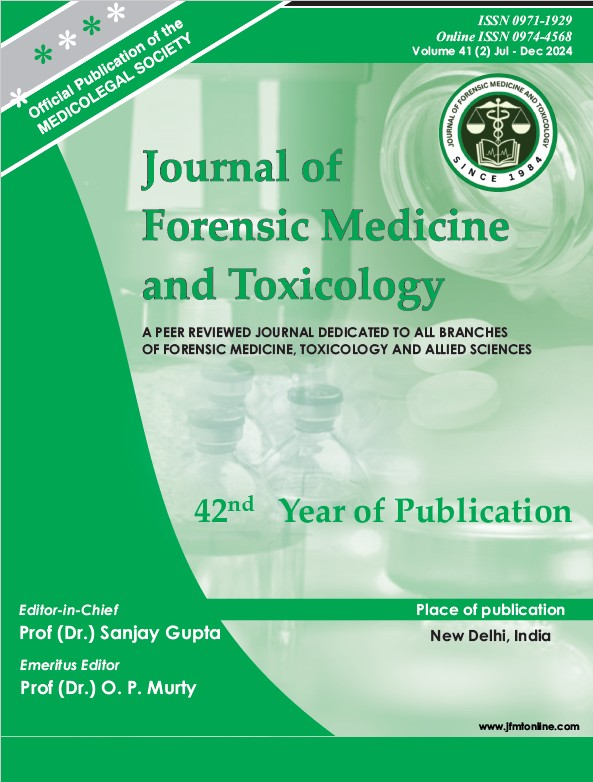Autopsy Analysis of Renal Lesions: A Histomorphological Perspective
DOI:
https://doi.org/10.48165/jfmt.2025.42.2.8Keywords:
Renal lesions, Histopathology, Autopsy studyAbstract
Objectives: The study aimed to evaluate the histomorphological spectrum of renal lesions in autopsy cases to determine the prevalence and distribution of renal pathologies among individuals who died suddenly and unexpectedly. Material and Methods: This cross-sectional, observational study was conducted over one year in the Department of Forensic Medicine and Toxicology at Government Medical College, Amritsar. A total of 160 autopsy cases were included, excluding those with autolyzed kidneys. Detailed gross and histopathological examinations were performed on all kidney samples, with additional PAS staining employed as necessary. Data on age, sex, and circumstances of death were recorded, and findings were statistically analysed using SPSS software. Results: Among the 160 cases, 70.3% exhibited histopathological abnormalities. Acute pyelonephritis was the most common lesion (24.975%), followed by acute tubular necrosis (14.85%). Glomerular sclerosis was observed in 11.25% of cases, and renal cell carcinoma in 2.7%. A male predominance was noted, with the highest frequency of renal pathologies in the 41-60 years age group. Gross examination revealed congestion in 61.25% of kidneys and cystic changes in 36.45%. Conclusion: The study underscores the significant incidence of renal pathologies, many of which remain undiagnosed during life, particularly among middle-aged males. The findings emphasize the critical role of autopsy in detecting occult renal conditions, offering insights that could improve the management and prevention of renal diseases.
Downloads
References
Kumar, V., Abbas, A. K., & Aster, J. C. (2020). Robbins and Cotran pathologic basis of disease (10th ed.). Philadelphia, PA: Elsevier. Retrieved from https://www.elsevier.com/books/robbins-and-cotran-pathologic-basis-of-disease/kumar/978-0-323-53175-4
Modi, P., Munjal, K., & Donga, B. N. (2017). Spectrum of renal lesions observed in autopsy study at tertiary care center. Journal of Clinical and Diagnostic Research, 11(4). https://doi.org/10.7860/JCDR/2017/25924.9781
Bhargava, P., Mehra, P., Jain, M., & Agarwal, P. (2016). Histopathological spectrum of renal lesions: An autopsy study. International Journal of Scientific Study, 4(3), 86–91. Retrieved from https://www.ijss-sn.com/uploads/2/0/1/5/20153321/ijss_jun_oa19_-_2016.pdf
Najar, M. S., Shah, A. R., Wani, I. A., & Banday, K. A. (2020). Histopathological spectrum of kidney diseases: A hospital-based study. Indian Journal of Nephrology, 30(1), 39–44. https://doi.org/10.4103/ijn.IJN_115_19
Gomes, A., Nunes, C., Quinha, P., et al. (2010). Trends in male mortality and life expectancy: Insights from European countries. Journal of Men’s Health, 7(3), 255–263. https://doi.org/10.1016/j.jomh.2010.06.002
Zhang, L., Wang, F., Wang, L., et al. (2012). Prevalence of chronic kidney disease in China: A cross-sectional survey. Lancet, 379(9818), 815–822. https://doi.org/10.1016/S0140-6736(12)60033-6
Hoyert, D. L., & Xu, J. Q. (2012). Deaths: Preliminary data for 2011. National Vital Statistics Reports, 61(6), 1–52. Retrieved from https://www.cdc.gov/nchs/data/nvsr/nvsr61/nvsr61_06.pdf
Heron, M. (2017). Deaths: Leading causes for 2015. National Vital Statistics Reports, 66(5), 1–76. https://doi.org/10.15620/cdc:44216
Bradley, E. H., Curry, L. A., Ramanadhan, S., Rowe, L., Nembhard, I. M., & Krumholz, H. M. (2009). Research in action: Using positive deviance to improve quality of health care. Implementation Science, 4, 25. https://doi.org/10.1186/1748-5908-4-25
Hansson, J., Nyberg, P., Törnblom, M., Back, S. E., & Scherstén, T. (2013). Renal pathology in forensic autopsies: A study of kidney diseases in the deceased. BMC Nephrology, 14, 48. https://doi.org/10.1186/1471-2369-14-48
Torres, V. E., Harris, P. C., & Pirson, Y. (2007). Autosomal dominant polycystic kidney disease. Lancet, 369(9569), 1287–1301. https://doi.org/10.1016/S0140-6736(07)60601-1
Brenner, B. M., & Rector, F. C. (2019). Brenner and Rector’s The Kidney (10th ed.). Philadelphia, PA: Elsevier. https://doi.org/10.1016/B978-0-323-55378-4.00001-6
Ahmed, M., Gattineni, J., Tuttle, S., et al. (2018). Histopathology of renal disease: An update. Current Opinion in Nephrology and Hypertension, 27(3), 233–240. https://doi.org/10.1097/MNH.0000000000000428
Singhal, R., Taneja, A., Roy, T. S., & Sharma, V. (2011). Incidental findings in renal pathology: A postmortem study. Indian Journal of Pathology and Microbiology, 54(3), 455–459. https://doi.org/10.4103/0377-4929.85776
Hill, N. R., Fatoba, S. T., Oke, J. L., Hirst, J. A., O’Callaghan, C. A., Lasserson, D. S., et al. (2016). Global prevalence of chronic kidney disease: A systematic review and meta-analysis. PLoS One, 11(7). https://doi.org/10.1371/journal.pone.0158765
Yoshino, T., Yamamoto, Y., Maekawa, K., Shimada, M., Watanabe, T., & Shiigai, T. (2012). Clinicopathological study of chronic tubulointerstitial nephritis: A 30-year experience. Clinical Nephrology, 77(1), 28–35. https://doi.org/10.5414/CNP7728
Weening, J. J., D’Agati, V. D., Schwartz, M. M., Seshan, S. V., Alpers, C. E., Appel, G. B., et al. (2004). The classification of glomerulonephritis in systemic lupus erythematosus revisited. Kidney International, 65(2), 521–530. https://doi.org/10.1111/j.1523-1755.2004.00495.x
Cattran, D. C., & Parsa, A. (2008). Management of primary membranous nephropathy. Current Opinion in Nephrology and Hypertension, 17(3), 231–238. https://doi.org/10.1097/MNH.0b013e3282f637ea
Shankland, S. J., Pollak, M. R., & Fervenza, F. C. (2009). Mechanisms of disease: Podocyte pathogenesis—What we have learned from animal models and human genetic mutations. Nature Clinical Practice Nephrology, 5(3), 173–182. https://doi.org/10.1038/ncpneph1014
Jemal, A., Siegel, R., Ward, E., Hao, Y., Xu, J., & Thun, M. J. (2009). Cancer statistics, 2009. CA: A Cancer Journal for Clinicians, 59(4), 225–249. https://doi.org/10.3322/caac.20006




